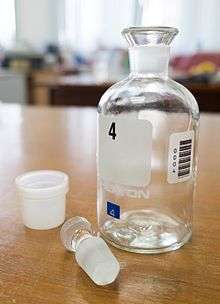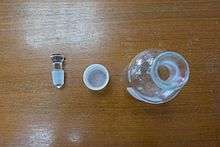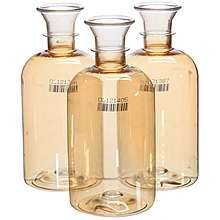BOD bottle
BOD Bottle or an incubation bottle is a main apparatus used for the Biological Oxygen Demand (BOD) test. During the 5-day BOD or BOD5 test process, the BOD bottle is used for incubating diluted samples under the 20 °C or 68 °F of temperature.

_(3231600029).jpg)
Structure

The bottle is normally designed to have a special shoulder radius to push out all air from the inside of the bottle when a sample solution is being filled into the bottle. According to the EPA Standard Methods for the Examination of Water and Wastewater or the Standard Methods 5210,[1] the BOD bottle should include a ground-glass stopper and a flared mouth which form a water seal preventing the air from the outside of the bottle coming in. The Standard Method 5210 also recommends to use a paper, a foil or a plastic cup to cap over the mouth of the bottle reducing the evaporation during the incubation. Generally, the side of the BOD bottle is permanently screened with white writing area, and is printed with a specific number; both for the aid of the sample identification.
- Stopper
There are two kinds of stopper: the Glass Pennyhead and the Glass Robotic stopper.[2]
- Sizes
There are many sizes of the BOD bottle. The dose of the mixture of the solution (nutrient, mineral and buffer solution) is related to the size of the bottle. For the Standard Methods 5210,[1] the BOD bottle “having 60 mL or greater capacity (300-mL)” is mentioned as one of the apparatus for the BOD test. However, 60 mL BOD bottle is recommended by EPA (Environmental Protection Agency) Method 405.1 stating that it is more convenient using this size of the bottle.[3]
Materials
Glass is a material being specified in the Standard Methods 5210 of the BOD5 test.[1] The glass bottles are manufactured from Type 1 borosilicate glass.
- A black BOD bottle
A black BOD bottle is coated with PVC plastic that block visible light. The black bottle is used in marine photosynthesis projects which needs the comparison of oxygen in the light and dark condition.[4][5]
- Disposable BOD Bottle or Carbonaceous Biochemical Oxygen Demand (CBOD) Bottle

It is a carbon-coated polyethylene terephthalate (PET) bottle. The bottle is solely manufactured by Environmental Express in Charleston, SC. The bottle is lightweight, unbreakable, and recyclable. Since the bottle is designed for single-use, it eliminates any potential for cross-contamination between samples. The bottle does not require any resources nor energy for cleaning and rinsing as it is disposable. CBOD bottle is also claimed to be cheaper, and cause less contamination in the sample solution than the conventional- BOD bottle.[6]
References
- American Public Health Association, American Water Works Association, Water Environment Federation. "Standard Methods for the Examination of Waterand Wastewater" (PDF).CS1 maint: multiple names: authors list (link)
- Scientific Instrument Services, Inc. "B.O.D. Bottle".
- "Biochemical Oxygen Demand (5 Days, 20°C)" (PDF).
- Taylor Scientific St. "Bottle - B.O.D. Black, Wheaton".
- "Wheaton Biological Oxygen Demand Bottles and Racks".
- Harstad, Marel; Townsend, Port; Brake, Perry. "Comparative Study Disposable Plastic vs. Traditional Glass BOD5/CBOD5 Bottles" (PDF).